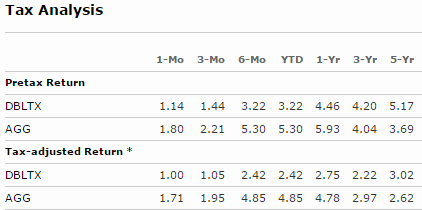I’ve called the 30 year bull market in bonds the greatest risk adjusted bull market ever because the figures are truly amazing. For instance, anyone who bought a 30 year T-Bond in 1985 generated about a 9% annualized return with just a 12% standard deviation. That’s 90% of the stock market’s return over the same period with just 68% of the risk. The investor who bought nothing but short-term Treasury Bills generated an average annual return of 5.25% with a standard deviation of just 4. That’s almost half of the stock market return with 25% of the risk.¹
Those days are long gone though. With overnight rates hovering just over 0% and long rates sinking ever lower the days of high bond returns are in the rear view mirror. Sure, inflation could jump in the coming years, but we still know that current yields predict low future returns and I think there’s a mountain of evidence in support of the idea that inflation will remain historically low for much longer. None of this bodes well for future bond returns.
This is particularly interesting within the context of actively managed bond funds. The fixed income space is often cited as a place where active management can actually make a lot of sense because there is the potential for greater strategic diversification than we generally see in the stock market. But it’s becoming increasingly difficult to squeeze alpha out of the fixed income stone in a falling interest rate environment. For instance, as MarketWatch and Fortune have cited, just look at the underperformance of the premier actively managed bond fund, DoubleLine’s flagship fund. But it gets worse when you open the hood and look even deeper. On an after tax and fee basis the Total Return fund has lagged the index for 3 years running due to the falling rate environment in which the margin for outperformance shrinks:
This isn’t a knock on DoubleLine – they just happen to be the 800 pound gorilla here. What I am highlighting is the razor thin margin of error in the active fixed income space. You could be the smartest bond manager in the world, but when the key industry benchmark is yielding just 1.75% your odds of generating alpha shrink significantly on an after tax and fee basis. For instance, in the case of DBLTX 27% of the benchmark’s yield is eaten up by the management fee alone. And that doesn’t even account for taxes. As a result, these managers have to be doing something extremely unusual to create any excess return in their portfolios in the coming years. I’ve argued in recent years that there’s a strong case that no one should be paying fees much in excess of a very low fee bond fund in an environment where you simply can’t squeeze much excess return from the stone.
Of course, none of this means bonds don’t have a place in your portfolio. I think the low interest rate environment has made many people irrationally negative about bonds. Bonds will still mitigate the risks of the stock market and perform better than cash will. But what this all highlights is the importance of taxes and fees in your portfolio. Although we can’t control the returns we earn we can control the frictions that reduce those returns. In a world of low future returns investors will need to maximize their real, real returns as much as possible. And this starts with being mindful of high fee managers and advisors as well as tax inefficient strategies.
¹ – Yes, standard deviation is an imperfect measure of portfolio risk, as I’ve described previously. However, it’s still a fine tool for some better perspective.
Mr. Roche is the Founder and Chief Investment Officer of Discipline Funds.Discipline Funds is a low fee financial advisory firm with a focus on helping people be more disciplined with their finances.
He is also the author of Pragmatic Capitalism: What Every Investor Needs to Understand About Money and Finance, Understanding the Modern Monetary System and Understanding Modern Portfolio Construction.


